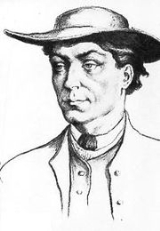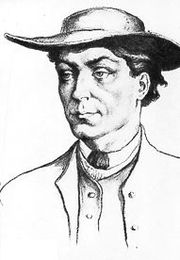
Anton Janša
Encyclopedia

Beekeeper
A beekeeper is a person who keeps honey bees for the purposes of securing commodities such as honey, beeswax, pollen, royal jelly; pollinating fruits and vegetables; raising queens and bees for sale to other farmers; and/or for purposes satisfying natural scientific curiosity...
and painter
Painting
Painting is the practice of applying paint, pigment, color or other medium to a surface . The application of the medium is commonly applied to the base with a brush but other objects can be used. In art, the term painting describes both the act and the result of the action. However, painting is...
. Janša is known as a pioneer of modern apiculture and a great expert in the field. He was educated as a painter, but was employed as a teacher of apiculture at the Habsburg
Habsburg
The House of Habsburg , also found as Hapsburg, and also known as House of Austria is one of the most important royal houses of Europe and is best known for being an origin of all of the formally elected Holy Roman Emperors between 1438 and 1740, as well as rulers of the Austrian Empire and...
court in Vienna.
Biography
Anton Janša was born in Breznica, CarniolaCarniola
Carniola was a historical region that comprised parts of what is now Slovenia. As part of Austria-Hungary, the region was a crown land officially known as the Duchy of Carniola until 1918. In 1849, the region was subdivided into Upper Carniola, Lower Carniola, and Inner Carniola...
(now in Slovenia
Slovenia
Slovenia , officially the Republic of Slovenia , is a country in Central and Southeastern Europe touching the Alps and bordering the Mediterranean. Slovenia borders Italy to the west, Croatia to the south and east, Hungary to the northeast, and Austria to the north, and also has a small portion of...
). At a young age Janša, together with his two brothers, showed a great interest in painting (they had a studio in their barn) and all three brothers, despite being illiterate, went to Vienna and entered the painters' academy there. His brother Lovro actually finished his studies at the academy and became a professor there, but Anton, despite a talent for painting, soon discovered that his true interests were in bee-keeping. His interest came early on, since his father had over one hundred hives at home and neighbouring farmers would gather at the village and discuss farming and bee-keeping. In 1769 he began to work full-time as a bee-keeper and a year later became the first royally appointed teacher of apiculture for all Austria
Austria
Austria , officially the Republic of Austria , is a landlocked country of roughly 8.4 million people in Central Europe. It is bordered by the Czech Republic and Germany to the north, Slovakia and Hungary to the east, Slovenia and Italy to the south, and Switzerland and Liechtenstein to the...
n lands. He kept bees in the imperial gardens (Augarten) and travelled around Austria presenting his observations in regard to moving hives to various pastures. He died in Vienna
Vienna
Vienna is the capital and largest city of the Republic of Austria and one of the nine states of Austria. Vienna is Austria's primary city, with a population of about 1.723 million , and is by far the largest city in Austria, as well as its cultural, economic, and political centre...
.
Importance
He became famous for his lectures in which he demonstrated his knowledge of bees. He also wrote two books in German: Discussion on Bee-keeping (1771) and A Full guide to Bee-keeping. The latter was published in 1775, after his death. In his Full guide he noted: Bees are a type of fly, hardworking, created by God to provide man with all needed honey and wax. Amongst all God's beings there are none so hard working and useful to man with so little attention needed for its keep as the bee. The Empress Maria TheresaMaria Theresa of Austria
Maria Theresa Walburga Amalia Christina was the only female ruler of the Habsburg dominions and the last of the House of Habsburg. She was the sovereign of Austria, Hungary, Croatia, Bohemia, Mantua, Milan, Lodomeria and Galicia, the Austrian Netherlands and Parma...
issued a decree after Janša's death obliging all teachers of apiculture to use his books.

Janša's beehive was preserved by Slovene bee-keepers and in 1884 a plaque was put on the house where he was born. The Museum of Apiculture in Radovljica
Radovljica
Radovljica is a town and a municipality in in the Upper Carniola region of northern Slovenia. The municipality has around 18,000 inhabitants and an area of 118 km²...
is also named after him.

